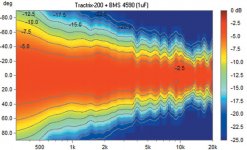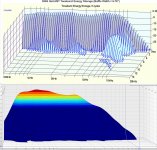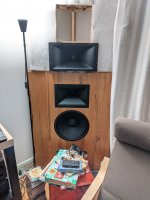I used my brain, and I found it! 
Mabat, wouldn't a large Horn have more directivity than a waveguide of the same diameter?

Mabat, wouldn't a large Horn have more directivity than a waveguide of the same diameter?
Well done, google search REW t=0, boomI used my brain, and I found it!
Not mabat but the amount of directivity (higher DI) is mainly related to the wall angle, narrower angle = higher DI.Mabat, wouldn't a large Horn have more directivity than a waveguide of the same diameter?
Isnt that like saying yes the large horn of the same mouth diameter has higher directivity because to match the wall angle the waveguide would become a horn?
Hmm seems an arbitrary distinction between horn and waveguide in that description.
If the mouth diameter is the same and you increase the depth then the wall angle will narrow and the directivity will rise.
To me the distinction between a horn and a waveguide is that a waveguide is designed primarily for directivity control and a horn is designed with acoustic amplification, "loading", increasing radiation impedance as a significant consideration. The difference is in the contour.
You could make a deep waveguide or a short horn, the depth doesn't determine whether it is one or the other.
Define what you want the device to do and design it accordingly, whatever you want to call it.
If the mouth diameter is the same and you increase the depth then the wall angle will narrow and the directivity will rise.
To me the distinction between a horn and a waveguide is that a waveguide is designed primarily for directivity control and a horn is designed with acoustic amplification, "loading", increasing radiation impedance as a significant consideration. The difference is in the contour.
You could make a deep waveguide or a short horn, the depth doesn't determine whether it is one or the other.
Define what you want the device to do and design it accordingly, whatever you want to call it.
OK if you have a waveguide and a horn with the same diameter mouth....the Horn would have to have a long enough axial length to create loading......I would think the only way to match the directivity of the horn at the point is to extend the axial length of the waveguide....if both are following the same expansion profile...at that point...they would be identical...wall angle is not the only factor (I think) duration of the wall via axial length also increase directivity.
Last edited:
Dr. Geddes,
I had some recollection that you mentioned it in another thread before, but could not find it.
Could you please elaborate on the reasons, results, and the like?
Kindest regards,
M
You probably won't believe this but my speakers had a 1st order HP - at 10 kHz!!
I had some recollection that you mentioned it in another thread before, but could not find it.
Could you please elaborate on the reasons, results, and the like?
Kindest regards,
M
OK if you have a waveguide and a horn with the same diameter mouth....the Horn would have to have a long enough axial length to create loading......I would think the only way to match the directivity of the horn at the point is to extend the axial length of the waveguide....if both are following the same expansion profile...at that point...they would be identical...wall angle is not the only factor (I think) duration of the wall via axial length also increase directivity.
I think you are tying yourself up in knots here. Much of the loading is created at the throat, to control directivity through to lower frequencies requires a larger diameter mouth and to keep the wall angle (horizontal pattern width) the same increases the needed depth.
What are you getting at with these questions, it's not clear to me.
Here I present a challenge that displays easier what I am trying to figure out.
Which waveguide can I use to create directivity as strong as the above down to 500hz....
At 500Hz the directivity is not very high in the above image. Anything with a big enough mouth to give you a 120 degree pattern at 500Hz, if you also want it to have a 50 degree pattern at 20K them it won't be pure OS. If you used Ath you would want to up the k parameter and make it deeper to get more slope to the directivity.
So directivity as strong as the above, down to 500hz, could be done with a wave guide with the same diameter mouth as the tractrix horn above? Or maybe I should stick with down to 800hz.
Last edited:
You cannot normalize group delay in REW for Burst Decay mode in the Waterfall...But We've seen the normalized Burst Decay in the other graph, I posted. This AMT should be a good example of how clean these style drivers can be. A good compare and contrast.
The cycle increments on the Axi+350 horn are units of 4.
Attachments
Last edited:
The directivity could easily be the same, but a tractrix would a have a different radiation impedance profile that would probably help the drivers output at 500Hz.So directivity as strong as the above, down to 500hz, could be done with a wave guide with the same diameter mouth as the tractrix horn above? Or maybe I should stick with down to 800hz.
A normalized polar map doesn't show you the raw output level so whilst the native directivities might be the same the output levels could be very different.
Regarding directivity, up to a frequency where the wavelength is about the same as the mouth diameter, it will be all virtually the same (so it's also not important what you mean by 'horn' or 'waveguide'). Then anything can happen.Mabat, wouldn't a large Horn have more directivity than a waveguide of the same diameter?
OK if you have a waveguide and a horn with the same diameter mouth....the Horn would have to have a long enough axial length to create loading......I would think the only way to match the directivity of the horn at the point is to extend the axial length of the waveguide....if both are following the same expansion profile...at that point...they would be identical...wall angle is not the only factor (I think) duration of the wall via axial length also increase directivity.
Why don't you describe the 2 different contraptions properly instead of insisting of calling it horn or WG and hope for an understanding of the difference. Isn't it obvious from earlier discussions that people have different views on this and that using the terms with a specific meaning is just open goal to have a misunderstanding. Try to post without using these 2 terms I you will see that things start to clear up. I suggest you call them acoustical transformers (AT) as a collective name 🙂
//
Oh, that reminds me - is there a chapter on vuvuzela? I'd love to read that. That and a mole cricket burrow. All landmark achievements.
In the meantime you could read this:
What makes the sound of vuvuzelas so annoying? | New Scientist
"The loudness can be explained by the bore shape, which is roughly conical, and flares. As well as creating sound at a frequency of 235 hertz, the instrument generates harmonics – sound at multiples of the fundamental frequency. We have measured strong harmonics at 470, 700, 940, 1171, 1400 and 1630 hertz."
It seems that a vuvuzela is more closer the the blueprint of your waveguides.
Btw, the history of musical wind instruments is highly interesting. They all have a very long tubes of different inner shape and they flare at the end. An experienced player can play clean and well sounding tones out of an vuvuzela.
All wind instruments beam "like hell" but no one would to the idea to turn them into high performance waveguides. If we speak we beam. Beaming is a natural thing to focus the sound.
Hmm, I see that the author of that article is on about the same level of education of the matter as you. From someone who apparently read the Book already, I would expect better. From all this, it seems to me that what must be the book seriously lacking is the summary on sound reproduction research.
So directivity as strong as the above, down to 500hz, could be done with a wave guide with the same diameter mouth as the tractrix horn above? Or maybe I should stick with down to 800hz.
You want a constant directivity horn of around 30 x 30 degrees that loads down to 250-300hz by the sounds of it. I don't think you know what you want, as you still haven't built or experienced anything first hand 😀
Here are some examples of CD horns that are of a wider coverage angle, but you can design your own without too much trouble
1.4" or 2" throat large constant directivity horns you can actually buy!
A K-402-Based Full-Range Multiple-Entry Horn - Technical/Modifications - The Klipsch Audio Community
Attached is my 2 way setup so far, where i previously had a peerless 2535 on a QSC clone waveguide, which sounded very clear and detailed but lacked weight.
Then testing a large format compression driver (JBL 2453J) with the horn from the first link (and a 3d printed adapter plate) crossed over at 600hz, instead of 1100
Plenty of weight, plenty of HF extension and detail, almost as good in the treble as the smaller horn setup
The cost of this was way lower than the time cost in analysis paralysis
Next is to build another set of klipsch K402 clones and another set of woofers and run this as a ceiling height WTW setup 😀
Attachments
Just by reading your words I get inspired to read again an article i came across some years ago about the theory of the existence of a parallel universe.
So tell me, isn't the loudness and the annoying sound of vuvuzela in fact caused by the very slow expansion, rather than a "roughly conical" shape? What's closer to that - a JMCL horn or an OS waveguide? How can you say such nonsense, even if it's driven just be an urge to pick on me (which is fine)? What of those two will generate stronger harmonics? Is that mentioned in the book? I suppose it is. The exact opposite is true of course. Come on, even humor should have some standard.
Last edited:
You want a constant directivity horn of around 30 x 30 degrees that loads down to 250-300hz by the sounds of it.
Yikes! 10^6/[250*30] = ~133.33"^2 !! It will definitely have to be a Synergy concept of small stadium proportions.
Methinks time to rethink your goals! 😉
- Home
- Loudspeakers
- Multi-Way
- Is it possible to cover the whole spectrum, high SPL, low distortion with a 2-way?


